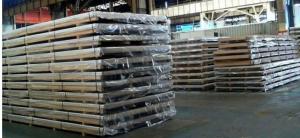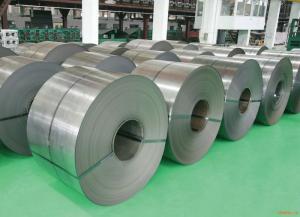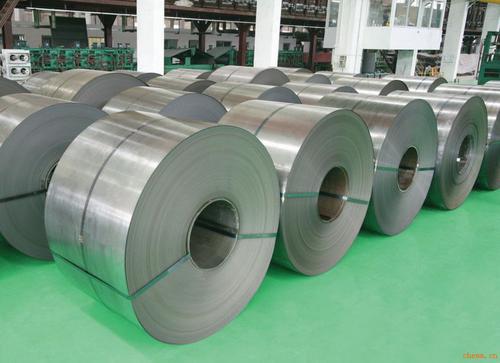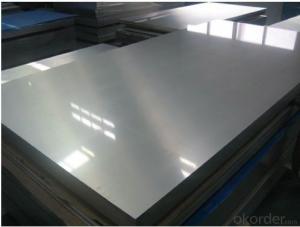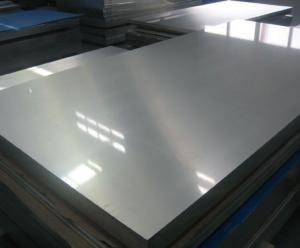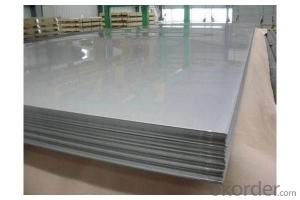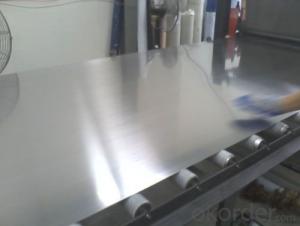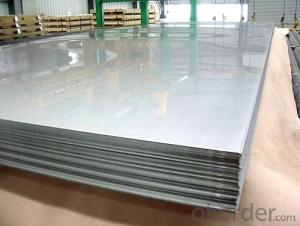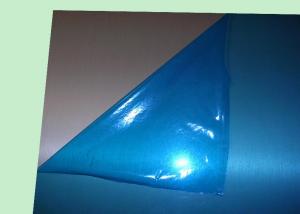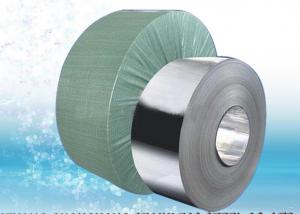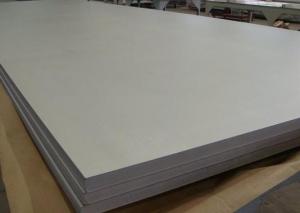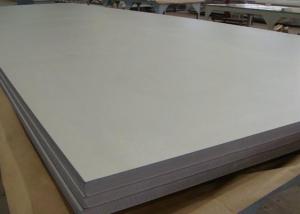FACTORY PRICE STAINLESS STEEL PLATE/SHEET PVC ON SIDE
- Loading Port:
- Shanghai
- Payment Terms:
- TT OR LC
- Min Order Qty:
- 50 m.t.
- Supply Capability:
- 10000 m.t./month
OKorder Service Pledge
OKorder Financial Service
You Might Also Like
Stainless Steel Plate
Specification:304,BA
PVC one side
Type | 2B/BA/6K stainless steel plate/sheet 304 304L |
Size/thinckness | 0.2mm-2.0mm |
Widthness | ≤1000mm or as your request |
Length | 1000mm-3000mm or as your requirement |
Standard | ASTM, AISI,GB, JIS etc |
Material | 201,202,304,304L,310s,316L,904L,316,321,410,420,430,etc |
Application range | Foodstuff, Gas, metallurgy, biology, electron, chemical, petroleum, boiler, nuclear energy, Medical equipment, fertilizer etc |
Packaging | export standard picking or as customers' requirement |
Delivery time | about 45 days working days after receiving the deposit |
Productivity | 2000 tons/month |
Chemical composition of Some Common Designations:
| Material No. | Main elements contained: maximum percentage(%) | ||||||
| C | Mn | P | S | Si | Gr | Ni | |
| 201 | 0.1 | 8.5-10 | 0.09 | 0.03 | 0.75 | 15.0-16.0 | 0.8-1.2 |
| 202 | 0.08 | 7.0-8.0 | 0.07 | 0.01 | 0.7 | 14.5-15.5 | 4.0-4.2 |
| 304 | 0.08 | 2.00 | 0.045 | 0.03 | 0.75 | 18.0-20.0 | 8.0-10.5 |
| 304L | 0.03 | 2.00 | 0.035 | 0.03 | 1.00 | 17.0-19.0 | 8.0-11.0 |
| 309 | 0.20 | 2.00 | 0.040 | 0.03 | 1.00 | 12.0-15.0 | 22.0-24.0 |
| 309S | 0.08 | 2.00 | 0.045 | 0.03 | 1.00 | 12.0-15.0 | 22.0-24.0 |
| 310 | 0.15 | 2.00 | 0.20 | 0.15 | 1.00 | 23.0-26.0 | 17.0-20.0 |
| 310S | 0.08 | 2.00 | 0.035 | 0.03 | 1.00 | 19.0-22.0 | 24.0-26.0 |
| 316 | 0.08 | 2.00 | 0.045 | 0.03 | 1.00 | 16.0-18.0 | 10.0-14.0 |
| 316L | 0.03 | 2.00 | 0.045 | 0.03 | 1.00 | 16.0-18.0 | 12.0-15.0 |
- Q: What is the composition of 111 stainless steel strips?
- The composition of 111 stainless steel strips typically consists of iron, chromium, and nickel as the main elements, along with small amounts of other elements such as carbon, manganese, and silicon.
- Q: Are stainless steel strips suitable for medical applications?
- Yes, stainless steel strips are suitable for medical applications. Stainless steel is a preferred material in the medical field due to its excellent corrosion resistance, durability, and ease of sterilization. The high levels of chromium present in stainless steel strips make them highly resistant to corrosion, which is critical for maintaining a sterile environment in medical applications. Additionally, stainless steel strips can withstand high temperatures and pressures that are often encountered during the sterilization process. The material is also strong and durable, allowing it to withstand the rigors of medical procedures and equipment. Moreover, stainless steel is biocompatible, meaning it does not react with bodily tissues or fluids, making it safe for implantable medical devices such as surgical instruments, orthopedic implants, and prosthetics. Overall, stainless steel strips are a reliable and widely used material in various medical applications due to their hygiene, functionality, and compatibility with the human body.
- Q: What is stainless steel strip?
- Stainless steel strip, a slender and flat piece of stainless steel material, is widely utilized in diverse industries for a multitude of purposes. It is composed of a corrosion-resistant alloy of iron and chromium, with the potential inclusion of elements like nickel or molybdenum. Its smooth and polished surface is attained through hot rolling, cold rolling, or annealing processes. Possessing exceptional strength, durability, and corrosion resistance, stainless steel strip is highly favored in numerous sectors. It is commonly employed in the production of components for kitchen appliances, automotive parts, construction materials, electronic devices, medical equipment, and various other products. Depending on the specific requirements of the application, stainless steel strip can be further processed to obtain different shapes, sizes, or thicknesses, showcasing its versatility. Furthermore, stainless steel strip is available in diverse grades and finishes, each exhibiting distinct properties and characteristics. Austenitic, ferritic, and martensitic grades are classifications within the stainless steel strip category, offering unique attributes such as high temperature resistance, magnetic properties, or enhanced strength. The selection of grade and finish is contingent upon the intended use and the environmental conditions to which the strip will be subjected. To sum up, stainless steel strip is an adaptable and resilient material that serves a myriad of purposes across various industries. Its corrosion resistance, strength, and malleability make it a dependable option for manufacturers in search of high-quality and long-lasting products.
- Q: Can stainless steel strips be used in the automotive stamping industry?
- Yes, stainless steel strips can be used in the automotive stamping industry. Stainless steel is a versatile material that offers several advantages for automotive applications. It is highly resistant to corrosion and oxidation, making it ideal for use in parts that are exposed to harsh environmental conditions. Stainless steel also has excellent strength and durability, which is crucial for automotive components that need to withstand heavy loads and impacts. Additionally, stainless steel strips can be easily formed and stamped into various shapes and sizes, making them suitable for a wide range of automotive stamping applications such as body panels, brackets, and reinforcements.
- Q: Can stainless steel strips be used in high-pressure applications?
- Yes, stainless steel strips can be used in high-pressure applications. Stainless steel is known for its strength, durability, and corrosion resistance, making it suitable for withstanding high-pressure environments.
- Q: Are stainless steel strips resistant to oxidation?
- Yes, stainless steel strips are resistant to oxidation due to the presence of chromium in their composition, which forms a protective layer on the surface, preventing oxidation and corrosion.
- Q: Are stainless steel strips available in different widths?
- Indeed, diverse widths of stainless steel strips can be obtained. These strips find widespread usage in multiple sectors, namely construction, automotive, and manufacturing. They are offered in a wide array of widths, catering to distinct project specifications. The width choices encompass slender strips, typically measuring approximately 0.5 inches or less, as well as broader strips that can extend to several inches or even more. The provision of various widths facilitates enhanced adaptability in the design and construction of diverse applications.
- Q: Can stainless steel strips be used for cladding purposes?
- Yes, stainless steel strips can be used for cladding purposes. Stainless steel is known for its durability, corrosion resistance, and aesthetic appeal, making it a popular choice for cladding applications. Stainless steel strips can be easily installed on various surfaces, including walls, columns, and facades, to provide a protective and decorative covering. Whether it is for commercial, industrial, or residential projects, stainless steel strips offer a versatile and long-lasting solution for cladding purposes.
- Q: What is the difference between stainless steel strips and stainless steel sheets?
- Stainless steel strips and sheets find extensive use across a variety of industries and applications, yet they vary in dimensions and functionality. Stainless steel strips encompass slender, elongated flat sections of stainless steel, usually measuring between 0.02 inches and 0.125 inches in thickness. They prove valuable in scenarios requiring meticulous measurements, such as automotive components, electrical connectors, and medical instruments. The strips' narrow width allows for greater flexibility in shaping and bending, rendering them suitable for intricate designs and constrained spaces. Conversely, stainless steel sheets consist of larger, flatter sections of stainless steel, available in diverse thicknesses ranging from 0.015 inches to 0.1875 inches or even thicker. These sheets commonly serve purposes demanding expansive surface areas, such as countertops, backsplashes, wall cladding, and roofing. By providing robust and durable surfaces, stainless steel sheets prove ideal for heavy-duty applications wherein structural integrity holds utmost importance. Another distinction between stainless steel strips and sheets lies in their availability and pricing. Stainless steel strips typically come in coils, enabling continuous production and minimizing waste. Consequently, this renders them more cost-effective when compared to stainless steel sheets, which often necessitate custom cutting, potentially leading to increased material expenses. To summarize, although both stainless steel strips and sheets originate from the same top-notch material, their dimensions and functions greatly vary. Stainless steel strips, with their narrow and thin composition, excel in precise applications, while stainless steel sheets, being wider and thicker, prove optimal for larger surface areas and structural purposes.
- Q: Can stainless steel strips be used in pharmaceutical applications?
- Yes, stainless steel strips can be used in pharmaceutical applications. Stainless steel is highly resistant to corrosion and contamination, making it suitable for use in pharmaceutical environments where cleanliness and sterility are crucial. Additionally, stainless steel is easy to clean, has good mechanical strength, and can withstand high temperatures, making it an ideal material for pharmaceutical equipment and components.
Send your message to us
FACTORY PRICE STAINLESS STEEL PLATE/SHEET PVC ON SIDE
- Loading Port:
- Shanghai
- Payment Terms:
- TT OR LC
- Min Order Qty:
- 50 m.t.
- Supply Capability:
- 10000 m.t./month
OKorder Service Pledge
OKorder Financial Service
Similar products
Hot products
Hot Searches
Related keywords
